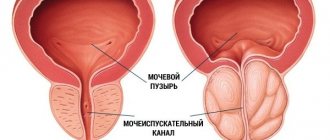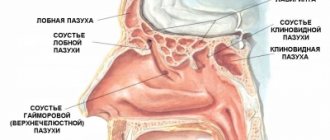General information
Nephritis is a group of kidney diseases of an inflammatory nature. There are two main forms in children: hereditary and acquired.
The inflammatory process usually occurs in both kidneys of the child, spreading to the pyelocaliceal system, renal glomeruli and tubules. This disease can appear even in newborns; in medicine there is currently no consensus on what the mechanism of the onset and development of the disease is. Acute tubulointerstitial nephritis is usually provoked in children by a hereditary predisposition, accompanied by infection and allergies. Source: N.I. Khlebovets Tubulointerstitial nephritis in children // Journal of Grodno State University, 2014, No. 1, pp. 94-97
Acute glomerulonephritis (nephritic syndrome) - symptoms and treatment
Acute glomerulonephritis can occur without symptoms for about three weeks [2][4][10]. Then a characteristic acute nephritic syndrome develops, including the main manifestations of the disease:
- swelling;
- hematuria (blood in the urine);
- hypertension [12][15].
Edema occurs in 80–90% of patients [16]. The appearance of edema in acute glomerulonephritis is caused by sodium retention and slow filtration of blood in the glomeruli [16]. In children, swelling spreads throughout the body; in adults, as a rule, only the legs and face swell. In 10–50% of cases, edema is accompanied by dull pain in the lower back, which occurs due to inflammation and stretching of the kidney capsule.
Urine acquires a red tint and becomes the color of “meat slop” in 30–50% of patients [16]. Visible staining of urine by blood clots is called gross hematuria. Other patients develop microhematuria—a small amount of red blood cells are present in the urine, but no blood is visible in the urine. Hematuria is the most typical manifestation of the disease; it can be the only symptom of glomerulonephritis and persist for several months after the illness.
Hypertension develops in 50–90% of patients , of which more than 75% of patients have severely elevated blood pressure [16][19]. Hypertension may be asymptomatic or manifest as headaches. The main causes of high blood pressure in acute glomerulonephritis are an increase in circulating blood volume associated with fluid and sodium retention, as well as an increase in cardiac output and peripheral vascular resistance.
From the first days of illness, the volume of urine excreted (diuresis) decreases. With treatment, it is restored within 4–7 days, after which edema disappears and blood pressure normalizes (hypertension is usually most pronounced at the height of the disease [16]). However, some symptoms may persist for another six months.
Acute post-streptococcal glomerulonephritis can occur in two forms:
- cyclically - typical option;
- acyclic - with only one symptom, atypical option.
Cyclic flow
The disease begins acutely: the condition worsens sharply, severe weakness, nausea, vomiting appear and the temperature rises.
Then nephritic syndrome develops:
- with renal symptoms - the volume of urine excreted decreases, blood, protein and cylindrical bodies appear in it;
- with extrarenal symptoms - headache, stomach or lower back pain, weakness, asthenia, decreased or loss of appetite.
The patient usually remembers that these symptoms were preceded by a sore throat, tonsillitis, scarlet fever, or other bacterial infection. The latent period after tonsillitis and exacerbation of chronic tonsillitis is 2-4 weeks, after streptoderma - 8-12 weeks.
Acyclic flow
Diuresis decreases, hematuria appears, but extrarenal symptoms do not occur, so the disease is usually tolerated more easily. It is impossible to predict how glomerulonephritis will develop - the course of the disease depends on the state of the immune system.
The main causes of illness in childhood:
- various maternal illnesses during pregnancy;
- diabetes;
- oncology;
- autoimmune processes;
- myeloma;
- vasculitis;
- acute infections;
- thrombosis;
- damage to the body by salts of heavy metals;
- self-medication with medications without specialist supervision (the use of antibiotics without appropriate prescription is especially dangerous);
- reactions to vaccines;
- hypothermia;
- tuberculosis.
1.What is chronic interstitial nephritis and its causes?
Chronic interstitial (tubulointerstitial) nephritis, abbreviated as CIN, is a non-infectious inflammatory disease of the kidneys. In chronic interstitial nephritis, the renal tubules and interstitial tissue are affected.
Causes of chronic interstitial nephritis
The causes of CIN can be very different. Acute interstitial nephritis (AIN)—untreated or undiagnosed—can develop into chronic interstitial nephritis. However, much more often chronic interstitial nephritis appears without AIN. The causes of interstitial nephritis can be:
- Intoxication of the body;
- Radiation;
- Metabolic disorders;
- Problems with the immune system;
- Infections;
- Abuse of certain drugs (analgesics, antipyretics and non-steroidal anti-inflammatory drugs).
It is also worth mentioning that in approximately every fifth patient the cause of chronic interstitial nephritis cannot be determined.
A must read! Help with treatment and hospitalization!
Symptoms of the disease
Symptoms are usually the same, regardless of the cause of kidney damage, and are also similar for children of any age - from newborns to teenagers:
- swelling;
- decreased appetite;
- general weakness;
- feeling of dry mouth;
- chills;
- skin redness;
- dry skin, hair, nails;
- headache;
- pain in the lumbar area;
- convulsions;
- small volume of daily urine;
- bloating;
- vomiting and other gastrointestinal disorders.
If the disease lasts for a long time, then the death of a large number of renal glomeruli occurs. As a result, kidney failure occurs.
The chronic form of the disease is characterized by:
- intense sweating, increasing at night;
- decreased appetite;
- yellow skin tone;
- frequent urge to urinate;
- pain during urination;
- cloudy urine.
Kidney inflammation (nephritis): diagnosis and treatment
Inflammatory processes accompanied by changes in the structure of the kidneys and disruption of their function are called nephritis. This is a common disease that requires accurate diagnosis for proper treatment. At the MedEx clinic, you can undergo an examination, based on the results of which the doctor will prescribe comprehensive treatment.
Symptoms of inflammation
At the very beginning of the disease, a person complains of general malaise; there are no specific symptoms of kidney inflammation. You may experience lower back pain, loss of appetite, and headaches.
As the disease progresses, the following symptoms appear:
- nagging pain in the lumbar region;
- decrease in urine volume;
- cloudy, dark-colored urine consistency;
- urinary incontinence (in the acute stage);
- swelling of the legs, arms and face;
- temperature increase;
- chills;
- pressure surges;
- nausea, gag reflex.
If you find several signs of inflammation in the kidney area, you need to consult a specialist. The doctor will conduct an examination, prescribe diagnostic tests and select a treatment regimen.
You should not resort to self-medication, as this can significantly aggravate the pathological processes. To avoid dangerous consequences, you should consult a urologist at the first symptoms of pathology.
Reasons for the development of nephritis
The disease appears for the following reasons:
- decreased immunity;
- respiratory infections;
- chronic inflammation;
- stones in the bladder and kidneys;
- impaired functioning of the kidneys and bladder.
The causes of nephritis may be complications of an infectious disease. Inflammation appears at 2–3 weeks of development of the acute form. Exacerbation of nephritis occurs with overwork, lack of vitamins, and general hypothermia.
Diagnosis of the disease
Kidney inflammation (nephritis) is diagnosed by a doctor at an appointment. For an accurate diagnosis, a number of measures must be taken:
- general tests;
- tests according to Nechiporenko, Zimnitsky, Volgard;
- ultrasound examination of the kidney to detect stones;
- kidney tissue biopsy.
If necessary, the doctor may order an x-ray or CT scan of the kidney.
Our clinic is equipped with modern equipment for high-quality diagnosis of nephritis. We conduct laboratory tests and instrumental diagnostics to obtain a complete picture of the causes and development of the disease.
Types of jade
Highlight:
1. Pyelonephritis is an inflammation of a bacterial nature.
2. Shunt - damage to the renal glomeruli with complications of antibody complexes.
3. Interstitial - occurs due to infection or medication. Inflammation develops in the interstitial tissue. With timely treatment, recovery occurs within a few weeks.
4. Glomerulonephritis - damage to the glomeruli in acute and chronic form. The acute form may appear suddenly after hepatitis or tonsillitis. To prevent kidney damage, it is necessary to seek medical help promptly.
5. Berger's disease (nephropathy) is a common form of nephritis that develops when antibodies are deposited in the kidneys. Nephropathy often affects men.
Treatment of nephritis
Based on the examination and research results, our specialist makes a diagnosis and decides how to treat nephritis - with the use of herbal remedies, medications and/or physiotherapy.
Drug treatment of nephritis involves a complex effect. The patient is prescribed an antibiotic, anti-inflammatory drugs, vitamins and restorative drugs.
Regardless of the method, quality rest and diet are essential. Food should be rich in minerals and microelements. You should refrain from spices, herbs and salt.
In advanced cases, when medications and physiotherapeutic procedures do not help, doctors can perform a gentle operation to resection or remove the source of infection. In case of renal failure, hemodialysis is used.
Preventive measures
To prevent kidney inflammation, it is necessary to support the immune system, avoid stress, hypothermia, and increased stress. When the first signs of inflammation appear, you should consult a doctor. Preventing a disease is easier than treating it and dealing with its consequences.
Diagnosis and treatment of nephritis in Moscow
At the MedEx personal medicine clinic, you can make an appointment with a urologist, who will conduct ultrasound and laboratory diagnostics of inflammation and prescribe a treatment regimen. Extensive experience of specialists and modern equipment allow us to identify the true causes of nephritis and effectively treat the disease at any stage.
To make an appointment, call us by phone or use the form on the website.
Classification of jades
| Type of jade | Peculiarities |
| Pyelonephritis | Inflammatory process in the pyelocaliceal system. It is bacterial in nature, provoked by E. coli, staphylococcus and a number of other pathogens. |
| Glomerulonephritis | The kidney glomeruli are negatively affected. It can be of three forms: acute, subacute and chronic. Characterized by swelling, blood in the urine, increased blood pressure. Source: Lechon FC, Espi MT, Abal RP, Peiro JLE Acute glomerulonephritis associated with pneumonia: review of three cases. Ped. Nephrol. 2010; 25: 161-164 |
| Interstitial nephritis in children | Damage to renal tissues and tubules. The causes are viruses, uncontrolled use of diuretics and antibiotics. |
| Tubulointerstitial | Damage to the interstitial tissue of the kidneys and tubules, aseptic inflammation of the tissues. The process involves the lymph flow and blood vessels. |
| Lupus | The cause is lupus erythematosus, which provokes inflammation not only in the kidneys. Source: G.A. Makovetskaya, L.I. Mazur, V.N. Barinov, E.A. Barannikova, E.M. Romadanova, P.V. Morinets Lupus nephritis in children: manifestation, diagnosis, treatment // Russian Bulletin of Perinatology and Pediatrics, 2021, No. 62(4), p.185-186 |
| Acquired diffuse | Streptococcal infection in a newborn, damage to kidney tissue. |
| Ray | It is provoked by ionizing radiation, as a result of which the function of the renal tubules is impaired. In the chronic form, renal failure or arterial hypertension develops. |
| Hereditary | At the beginning of development, symptoms are almost completely absent. As the disease progresses, hearing and vision may decrease, unusual fatigue may appear, and the skin often turns pale. |
Interstitial nephritis (Tubulointerstitial nephritis)
The mechanism of development of interstitial nephritis depends on the nature and intensity of the damaging factor. Often, inflammation has an autoimmune basis and is provoked by the deposition of immune complexes circulating in the blood (during lymphoproliferative processes, systemic lupus erythematosus, taking non-steroidal anti-inflammatory drugs) or antibodies to the basement membrane of the tubules (during antibiotic intoxication, transplant rejection).
When the process is chronic, an important role is played by the pathological activation of macrophages and T-lymphocytes, which cause proteolysis of tubular basement membranes and enhance peroxidation with the formation of free radicals. Sometimes the tubular epithelium is damaged as a result of selective accumulation and direct destructive action of a nephrotoxic substance reabsorbed from primary urine.
Local release of inflammatory mediators in response to the action of a damaging factor causes swelling of the interstitium and vascular spasm, which is aggravated by their mechanical compression. The resulting ischemia of the renal tissue potentiates dystrophic changes in cells, reduces their functionality, and in some cases provokes the development of papillary necrosis and massive hematuria.
Due to increased pressure in the tubules and a decrease in effective plasma flow, the filtering capacity of the glomerular apparatus is secondarily impaired, which leads to renal failure and an increase in serum creatinine levels. Against the background of edema of the interstitial tissue and damage to the tubular epithelium, water reabsorption decreases and urination increases.
In acute nephritis, a gradual decrease in edema of the interstitial substance is accompanied by restoration of renal plasma flow, normalization of the glomerular filtration rate and the efficiency of tubular reabsorption. The long-term presence of damaging agents in combination with persistent stromal ischemia against the background of blood flow disturbances entails irreversible changes in the epithelium and replacement of functional tissue with connective tissue fibers.
Sclerotic processes are enhanced by stimulation of fibroblast proliferation and collagenogenesis by activated lymphocytes. Hereditary predisposition plays a significant role in the occurrence of a hyperergic inflammatory reaction.
Methods of treating the disease
Important! Treatment should only be carried out by a doctor who strictly controls the course of therapy. It is prohibited to try to cure a child on your own, use folk remedies, or rely on the experience of other parents.
After making a diagnosis, the doctor prescribes a special diet for the child. The child must be kept in bed and not be exposed to stress or stress.
Drug therapy is carried out using vitamin complexes and antibiotics. It can be adjusted if the expected effect is not achieved. The duration of drug treatment is usually long - up to one and a half months.
Sometimes (in the presence of toxins in the blood plasma) plasmapheresis and hemosorption (blood purification) are performed.
Any therapy requires the participation of a specialist and regular tests to monitor the progress of treatment. When the main course is completed, children are often sent to sanatoriums and physiotherapy is recommended.
4. Treatment of chronic interstitial nephritis
The first step in treating chronic interstitial nephritis is to stop taking medications that negatively affect the kidneys. With early diagnosis, this can prevent the disease, and at later stages, stop or slow down the destructive processes.
The rest of the treatment for chronic interstitial nephritis is symptomatic. Medicines and vitamins are prescribed to support kidney function. Depending on your symptoms and underlying medical conditions, dietary changes may be necessary. In severe cases, intravenous infusion of electrolytes and fluids is performed.
Methods for preventing childhood nephritis
Parents should be aware that self-prescription of preventive medications is unacceptable. Even after an examination, only a doctor should do this.
As part of prevention, it is important to monitor the child’s lifestyle, promptly identify alarming symptoms, and conduct medical examinations in this profile. For children at risk, physical therapy, hardening, moderate physical activity, and adherence to a certain diet are recommended (consult a doctor to determine this).
Advantages of SM-Clinic
Our medical center employs some of the best specialists in the Northern capital: pediatric nephrologists, urologists, pediatricians.
“SM-Clinic” has modern equipment, thanks to which diseases are diagnosed quickly and accurately. This makes it possible to return children to normal life in a short time. We have no queues, the approach to each child is always individual and delicate. If inpatient observation is required, comfortable rooms are provided.
Sources:
- N.I. Khlebovets. Tubulointerstitial nephritis in children // Journal of Grodno State University, 2014, No. 1, pp. 94-97.
- Lechon FC, Espi MT, Abal RP, Peiro JLE. Acute glomerulonephritis associated with pneumonia: review of three cases. Ped. Nephrol. 2010; 25: 161-164.
- G.A. Makovetskaya, L.I. Mazur, V.N. Barinov, E.A. Barannikova, E.M. Romadanova, P.V. Morinets. Lupus nephritis in children: manifestation, diagnosis, treatment // Russian Bulletin of Perinatology and Pediatrics, 2021, No. 62(4), pp. 185-186.
Lavrishcheva Yulia Vladimirovna Clinic
Author of the article
Lavrishcheva Yulia Vladimirovna
Doctor of the first qualification category
Specialty: nephrologist
Experience: 13 years
The information in this article is provided for reference purposes and does not replace advice from a qualified professional. Don't self-medicate! At the first signs of illness, you should consult a doctor.
Prices
| Name of service (price list incomplete) | Price |
| Appointment (examination, consultation) with a medical specialist, primary, therapeutic and diagnostic, outpatient (other specialties) | 1750 rub. |
| Consultation (interpretation) with analyzes from third parties | 2250 rub. |
| Prescription of treatment regimen (for up to 1 month) | 1800 rub. |
| Prescription of treatment regimen (for a period of 1 month) | 2700 rub. |
| Consultation with a candidate of medical sciences | 2500 rub. |
| Kidney ultrasound | 1700 rub. |
| Ultrasound scanning of kidney vessels | 2500 rub. |




